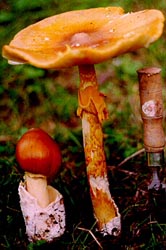>
|
[ Section Caesareae page. ]
[ Amanita Studies home. ]
[ Keys & Checklist/Picturebooks ] "Cinnamon Slender Caesar"
Technical description (t.b.d.) BRIEF DESCRIPTION: The cap of Amanita cinnamomescens is 73 - 180 mm wide, usually orange-brown over the center and throughout the cap in unexpanded specimens (infrequently, with pigment failing to develop in some sectors--see photos on left and right above), orange to orangish tan to yellowish tan to grayish yellow to pale brownish ochraceous toward the margin, with ridges in the striate region concolorous with the center and with yellow-orange grooves, pale brownish ochraceous in age, irregularly ovoid to campanulate at first, then convex or plano-convex, finally planar or subconcave, umbonate, entirely smooth or with slight wrinkling around the umbo, moist, with a striate margin (35 - 50+% of the radius), somewhat incurved at first, remaining decurved even when the cap is fully expanded, nonappendiculate. Volval remnants are absent. The flesh is orange below the cap skin, then fading to yellow-orange to white above the gills, with a white portion becoming grayish yellow to yellowish gray when cut or bruised. Gills are free, close, pale yellow in side view, up to 6 mm broad, with some reverse forking, with yellow-orange and flocculose edge or occasionally irregular and darkening with age or becoming light brown or orange-brown to dark brown on bruising. The short gills are truncate to rounded truncate, common, unevenly distributed, and of diverse lengths. The stem is 100 - 300 × 10 - 23 mm, sometimes pale yellowish at first, orange-yellow to yellow-orange to pale ochraceous brown in mature material, narrowing upward slightly, slightly flaring at the top of the stem, floccose-fibrillose, with fibrous squamules orangish tan, becoming ochraceous brown to brownish orange and finally dark brown. The ring is superior, membranous, copious, skirt-like, at first concolorous with the stem, then darkening as do the squamules on the stem, in age darker than stem and cap, finely striate above, felted below, eventually collapsing on the stem. The saccate volva is up to 67 × 27 mm, ellipsoid, rather fleshy, very thick proportionately, leathery and white on exterior surface, connected only to very bottom of stem in mature material. The flesh is pale yellow, unchanging when cut or bruised, and hollow. The spores measure (7.8-) 8.5 - 11.8 (-18.0) × (6.0-) 6.4 - 8.9 (-11.9) µm and are ellipsoid, occasionally broadly ellipsoid, infrequently elongate and inamyloid. Clamps are present at bases of basidia. This species was originally described from Pakistan and Nepal and still known only from these countries. In the Northwest Frontier Province of Pakistan, this species is montane occurring between 2400 and 2600 meters elevation and associated with fir (Abies pindrow). Habitat in Nepal is unknown. This species is sold in markets in Nepal. The two most similar species in Amanitastirps Hemibapha are Amanita javanica (Corner & Bas) T. Oda, C. Tanaka & Tsuda and Amanita similis Boedijn in the sense of Japanese authors. -- R. E. Tulloss, S. H. Iqbal, A. N. Khalid, and L. Possiel Photos: S. H. Iqbal & A. N. Khalid (Northwest Frontier Province, Pakistan).
[ Section Caesareae page. ]
[ Amanita Studies home. ]
[ Keys & Checklist/Picturebooks ] Last changed 30 September 2009 |


